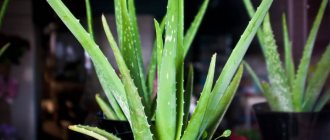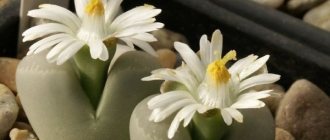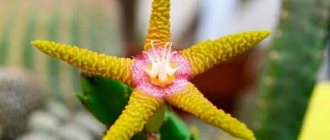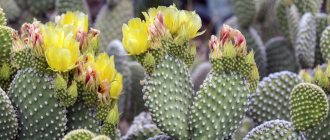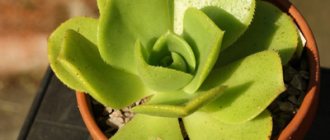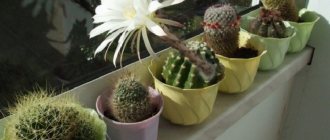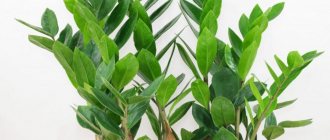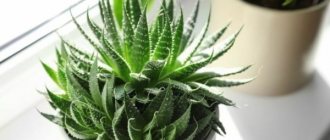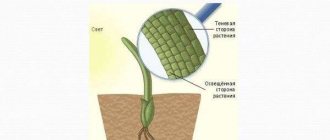Everyone knows this hardy cactus with edible fruits. Prickly pear has flat, succulent shoots of round or oval shape, like ears or flat cakes. They grow from one another at different angles, forming bizarre silhouettes. It happens that a traveler who finds himself in such thickets finds it very difficult to get out of there.
The shoots of prickly pear, like all cacti, have halos - highly modified axillary buds with long sharp spines and bunches of thin spines - glochidia. These villi are very insidious. They have serrations at the ends, like an arrowhead. When they come into contact with the skin, they break off and attach to it, causing irritation and itching.
Prickly pear flowers are solitary, sessile, large and showy, reminiscent of roses. The color is white, yellow, orange, red in different shades.
The fruits are large, juicy and also have spines on the outside. Collect them using thick gloves. The seeds are dark, round, with a hard shell (1).
In tropical and subtropical climates, prickly pear is grown as a food and fodder plant - it is a favorite delicacy of donkeys. Young shoots, cleared of thorns and glochidia, are used as vegetables - fresh, fried, baked, pickled. Large sweet fruits, despite the difficulty of peeling them, as well as the large number of seeds hard as shot, are a delicacy in many countries. They are used to prepare molasses, preserves, raw jam, marmalade, marshmallows, dried fruits, drinks - syrup, juice and wine. On the island of Malta, several companies produce the signature aromatic liqueur Bajtra from prickly pear fruits, which tourists take with them.
Opuntia is not without medicinal properties. The juice of some of its species has a wound-healing effect. Fleshy shoots are used in folk medicine for compresses and in the treatment of burns.
Inside old prickly pear shoots there is non-rotting wood - strong, but at the same time porous and twisted. Candlesticks, handles, and polished jewelry are made from it.
In ornamental gardening, prickly pear is used in landscape compositions in gardens and parks, and also as hedges.
Prickly pears have been known as a houseplant since the beginning of the 18th century, but indoors they bloom reluctantly and only under favorable conditions, and, as a rule, do not produce fruit. However, in winter gardens and wall-mounted heated greenhouses of cottages and country houses, their chances for the full life cycle of shoots are noticeably increased, especially with additional lighting (2).
Young plants usually bloom at 10 years of age or older.
Interesting fact According to ancient legend, the Aztecs, tired of long wanderings in the mountains, stopped on the shore of the beautiful Lake Texcoco and saw an eagle tearing apart a snake on a large prickly pear tree. This was a good sign from the gods and the tribe founded the city of Tenochtitlan here - “Place of the Sacred Prickly Pear” - present-day Mexico City. Now this scene from the legend is depicted on the Mexican coat of arms.
Botanical description
Fig prickly pear (Opuntia ficus-indica) has articulated stems and shoots that are cylindrical, spherical or flattened. The bushes grow to a height of 4 m, and their diameter is 2 m.
The plant is completely covered with thorns, large and hard thorns . The cactus blooms spectacularly, as it can have red, yellow, yellow-orange flowers. As soon as they wither, large egg-shaped fruits are formed, which are called “prickly pears.” Inside they contain flat seeds with a hard skin. The fruits are also covered with blind tufts, the tips are curved, which can only be seen under a microscope.
The roots of these cacti are powerful, they develop more in width than in depth. You can identify fig prickly pear by the shade of the fruit pulp. It can be white or bright red. Popularly, this plant has received several names:
- mother-in-law's tongue;
- eared cactus;
- dragon fruit;
- fig cactus.
Differences from other species
The main advantage of this plant is its absolute endurance . Opuntia fig can grow in a variety of conditions, even after the stems have withered and without prolonged watering. The cactus blooms beautifully in its natural environment, so at home the flowering will be more luxuriant and longer.
In addition, the plant has small hairs with numerous spines. If you touch them, the jagged spines will begin to easily separate and cling to clothing. This difference in the fig prickly pear is its disadvantage.
Useful and healing properties
Since prickly pear leaves contain calcium and potassium, they will help the body produce insulin , so using them effectively to treat diabetes. If you consume prickly pear products, they will reduce the formation of fats and improve their elimination from the body. The fibers of the plant swell and increase the volume of food in the stomach, and this reduces appetite. Because of this, weight, blood sugar and cholesterol levels decrease.
The fruits of the prickly pear fig contain a lot of vitamin C, which is beneficial for the body. It strengthens it, increases protective functions and activates the immune system.
Herbal preparations obtained from prickly pear are effective in eliminating cellulite and swelling, and promote the release of excess fluid. In addition, prickly pear contains substances that reduce intoxication during hangover syndrome.
Read more about the healing properties of prickly pear, the chemical composition and use of the cactus here.
What it is?
The prickly pear cactus is a plant native to South America and Mexico. It is often called nopal, thereby shortening its botanical name Nopalea cochenillifera. This species is popular in traditional medicine of Latin American peoples. It is used for:
- improving skin condition;
- normalization of sleep;
- relief of the condition of diabetics;
- increasing the strength of dental tissues and other bones;
- prevention of cancer;
- building immunity in general.
The prickly pear looks quite attractive. Moreover, its color depends not only on the specific variety, but also on the maturity of the plant. Specimens of orange, yellow, light green and red colors have been described. The ground part of the plant resembles a pear and extends to approximately 0.07 m in length.
Prickly pear fruits can be colored red, white, or green. There are also purple and yellow fruits. It is known that their taste is vaguely reminiscent of ripe raspberries. In addition to its natural habitat, prickly pear grows in African and Mediterranean countries, even in Australia. It is noted that it perfectly adapts to partially arid regions, populating fields and areas made of sandy soils.
Biologists suggest that the species formed in Mexico, and from there it spread throughout Central America. Wild prickly pear discovered in Jamaica. They try to grow it in a variety of countries because the fruit is beautiful, nutritious and healthy. In addition to microelements, the fruit also contains vital essential amino acids. The berries can be eaten only after removing the extremely sharp (like a well-sharpened straight razor) thorns.
In Russia, prickly pear is most often used as a decorative species. But if you still decide to use it for food, you must strictly limit the amount of the product. Otherwise it may be dangerous
Particular care should be taken when:
- lack of blood sugar;
- low blood pressure;
- excess cholesterol;
- disorders of the thyroid gland;
- two types of diabetes;
- asthma;
- runny nose and other respiratory diseases;
- immunosuppression;
- liver problems;
- pregnancy and lactation;
- treatment of any kind of disease (without the direct permission of a doctor).
Caring for Opuntia ficus indica
Despite the fact that it is even practiced to plant the plant in the ground in a temperate climate, there are optimal conditions for development and flowering.
Watering
Opuntia fig is very demanding when it comes to watering. But just do this carefully to prevent rotting of the root system. It is worth moistening the soil as needed, only after the earthen layer of soil has dried out. In winter, the plant does not need watering . Use soft and slightly acidic water, acidifying it with 2-3 drops of lemon juice.
The best way to water is in a tray, since if water gets on the leaves, a plug of known water deposits may become clogged, and the growth of the plant will be retarded.
Top dressing
Fertilizers must be applied during the period of active growth - spring and summer. Do this once a month. You need to use ready-made fertilizers for cacti with low nitrogen levels. An excess of this component will lead to rotting of the root system.
Temperature
The room in which the prickly pear is located must be regularly ventilated, just avoid drafts. In summer, the optimal air temperature for prickly pear is 25-35 degrees. In winter, the plant needs a cooler temperature of 5-18 degrees.
Light
Opuntia fig is a light-loving plant, so for its active growth and development it needs bright lighting. But it is better to accustom the cactus to direct sunlight gradually .
Humidity
Prickly pear tolerates dry air well, so it does not need spraying. But still, it is best to grow it at 60-70% humidity.
Priming
To replant a cactus, you need to prepare light and loose soil, and it must also allow moisture to pass through well.
You can buy ready-made substrate for cacti or prepare it yourself. In this case, you need to mix the following components in equal proportions:
- leaf soil;
- turf land;
- peat;
- sand;
- pebbles;
- broken brick.
Pot
For prickly pear, you should choose a wide, but not too deep pot . A plastic container with large drainage holes is best.
Transfer
The transplant is performed as follows:
Prepare the pot and disinfect it.- Place a drainage layer on the bottom of the container.
- Fill the pot with prickly pear substrate.
- Before planting, do not water the cactus, but transplant it into new dry soil. Then install it in a slightly shaded place and do not water for 7 days.
- After 7 days, you can place the container with the cactus in the light, provide regular watering, but do not feed it.
Below is a visual video about the process of transplanting prickly pear:
Trimming
The prickly pear pruning process looks like this::
- Prepare a sharp knife or blade, which must be treated with alcohol in advance.
- Trim the plant stem to about 60 cm.
- Treat the cut area with crushed activated carbon, and do not water the plant itself for 2-3 days.
Use in folk medicine
All parts of the plant are used for treatment: flowers, fruits, leaves (blades) and roots. In folk medicine, decoctions and infusions are prepared from the plant and consumed fresh.
For rheumatism, prepare a tincture: several leaves (approximately 100-200 g) are crushed, placed in a dark container, poured with 500 g of vodka, and infused for 2-2.5 weeks. It is recommended to use 15 drops every day during an exacerbation of the disease. The same tincture is also used externally: lubricate the legs, and then wrap them in a blanket. Crushed blades in the form of a paste are also used, which are applied to the affected areas as compresses.
For measles and pneumonia, prepare a decoction: 50 g of fig blades are finely chopped, poured with cold water (100 g), brought to a boil and simmered over low heat, boiling the mixture to 100 g (25-30 min). The decoction is filtered and taken: for pneumonia - 3 times a day, 1 teaspoon; for measles – 3 times a day, 2 tbsp. spoons.
For bronchial asthma, an infusion will help fight the disease: mix 200 g of finely chopped green parts, 500 g of honey and 500 g of Cahors, leave for 20 days. Take 1 tbsp three times a day before meals. spoon.
For coughs, bronchitis, and tuberculosis, a mixture of the juice of prickly pear (0.5 tbsp) and marshmallow (0.5 tbsp), which is mixed with 0.5 tsp of honey, will help. The juice must be fresh and cannot be prepared. The product is taken after meals three times a day. A decoction of eyebright herb will also help alleviate the patient's condition.
For diabetes mellitus, it is recommended to eat 30 g of fresh cactus blades three times a day, 0.5 hours before meals. This method will help reduce blood sugar levels. It also removes bad cholesterol. In this case, the use of sea buckthorn will also be useful.
In case of disturbances in the gastrointestinal tract, it is recommended to use a tincture: 1/2 cup of green cactus pulp minced through a meat grinder, mixed with a glass of sugar, kept in a dark place for 3 days. After this, add 250 g of red fortified wine and leave for another 24 hours. The resulting mixture is filtered and drunk half an hour before meals, 1 tbsp. spoon twice a day
It is important to strictly adhere to the dosage. To achieve a positive effect, you must complete a 30-day course of treatment.
For stomach diseases, you can use the following recipe: 2-3 tbsp.
spoons of finely chopped cactus and the peel of 1 tangerine are placed in a thermos, poured with 2 glasses of boiling milk and left for 12-14 hours. The strained broth is taken half a glass before meals three times a day.
In case of inflammatory processes of the skin, wiping the affected areas with juice obtained from the leaves of the plant will have a positive effect.
For prostatitis and for its prevention, a decoction that is used to treat measles and pneumonia will be effective. They take it according to the following scheme: 3 times a day, 50 g after meals for a month, after which they take a break for 2-3 weeks, then continue again.
For cystitis and urethritis, a decoction of the roots, which has a diuretic effect, will help: 5 blades are crushed using a meat grinder, squeezed through gauze, then add 50 g of water and squeeze again. The mixture is taken three times a day 20-30 minutes before meals, 1-2 tbsp. l., eating honey (can be sugar).
For obesity, it is recommended to eat 100 g of fresh fig leaves every day. Its rich vitamin composition, fibrous structure and fat-burning properties will allow you to balance your diet while reducing food volumes, speed up the feeling of fullness and remove excess fats from the body.
When the immune and hormonal systems are weakened, a tincture is used: several cactus flowers are mixed with the partitions of three walnuts, poured with vodka (500 g) and infused for a week in a dark place. Take this infusion three times, 1 tbsp. spoon before meals for 10 days. You can replace the tincture with a decoction of fescue.
To prevent colds and flu, a remedy used to strengthen the immune system will help. It is also recommended to prepare the following infusion: several crushed prickly pear blades are mixed with linden flowers (2 tablespoons), poured with boiled water (take 10 parts of water for 1 part of the mixture), leave for 12-14 hours, filter. Take half a glass after meals three times a day.
Growing methods
Reproduction by cuttings
This method of growing prickly pear is done as follows:
- The best time for cuttings is the end of spring - the beginning of summer, when the baby has been separated from the mother plant and left for a day to dry.
- Place the dried shoot in damp sand or soil.
- Place the young plant in a slightly shaded place for 7 days and stop watering.
- Only after 7 days can you begin to moisten the substrate. And as soon as the first roots appear, transplant the young prickly pear into a permanent container.
We invite you to watch a video about the process of prickly pear cuttings:
Seeds
The seed propagation method has the following features:
It is better to carry out reproduction at the end of the dormant period - in March.- Soak the seeds for 20 minutes in a slightly pink solution of potassium permanganate. In order for a seed to germinate, you need to break the integrity of its shell and rub it with sandpaper or a stone.
- The soil, consisting of soil and sand, must be disinfected, and then the seeds must be sown, covering the crops with plastic film.
- Place the container in a room where the temperature is 19-21 degrees. Water the soil once a week.
- As soon as the seeds hatch and the seedlings become strong, transplant them into separate containers and place them closer to the light.
We invite you to look at the process of planting prickly pear seeds:
Reproduction of Opuntia indica
This type of cactus can be propagated by seeds or segments (cladodes).
The process of propagation by stem segment
Use a knife to cut off a segment of Prickly Pear that is at least six months old. Set the cutting aside, standing it upright, until a callus forms at the cut site. The wound in a dry room will heal in one to two weeks. In wet conditions it will take longer.
Dip the hardened cut area in 3% Bordeaux mixture to protect it from fungal infection. Plant the cutting vertically to a depth of about 2.5 cm in a soil mixture of 1 part sand or perlite and 1 part regular soil. Use a support to secure the cutting and keep it upright. Do not water the soil. Prickly pear pads contain moisture, allowing roots to grow on them. If you water the stem at this stage, it may rot.
Moisturizing the soil should begin in a month, when the roots have formed and it itself is fixed vertically. It is necessary to water when the soil dries out.
Propagation by seeds
Cut the ripe fruit, remove a few seeds and rinse the pulp to remove the seeds. Let them dry completely. Prepare the pot and soil as described above. The soil should be slightly moistened. Place the seeds on the surface of the soil and lightly cover them with a thin layer of soil or sand. Then cover the pot with clear plastic wrap and place it in a warm, sunny place. Seed germination may take several weeks or months.
Diseases
Overwatering causes brown spots to form on the stem of the prickly pear fig . These are harbingers of the beginning of plant rotting. To save the cactus, you need to cut out the spots and treat all affected areas with a layer of crushed activated carbon. The soil in the pot should be treated with a mixture of carbendazim and watering should be reduced.
In case of insufficient lighting and waterlogging of the soil, the stems of the plant will become covered with wrinkles. And if there is a lack of nutrients in the soil, the growth of prickly pear stops.
Fig prickly pear is not the only species. We talked about different types of plants on our website, and we also suggest reading about the healing properties, chemical composition and use of prickly pear.
Similar flowers
The following flowers are similar in appearance to prickly pear:
- Heliocereus . It is a bushy epiphytic plant that produces thin, long stems. There are no spines, and the flowers are red and 20 cm in diameter.
- Pachypodium . This is an original crop with a trunk that resembles a cactus. The powerful stem is covered with thorns and narrow leaves.
- Euphorbia resiniferous . This plant is distinguished by a tetrahedral stem, on which there is bluish-green foliage. On the ribs of the milkweed are warty projections with spines.
- Stapelia . This is a perennial succulent that has tetrahedral fleshy shoots, the height of which is 60 cm.
- Echeveria . This is a perennial plant with oval leaves collected in a spectacular rosette, reminiscent of a rose. The color of echeveria is bluish-blue.
Opuntia fig is not just a beautiful house plant, but also incredibly useful. Its berries and leaves are often used in folk medicine. The cactus is not picky when it comes to care; it does not have any special requirements for watering, fertilizing and soil, so even a beginner can cope with all the work.
What does the Opuntia cactus look like and photos of its fruits
Most Opuntiaceae are unsuitable for indoor culture due to their large size, dangerous spines, low decorative value, or high requirements for living conditions.
However, among these succulents there are several species that are popular with cactus growers and are easy to cultivate.
For us, Opuntias are exotic, ornamental plants, but in their homeland they are one of the most common and rather annoying plants. In various areas of both Americas, thickets of Opuntia are found everywhere. They are completely impassable due to sharp, strong spines sticking out in all directions and pervasive glochidia. Moreover, even the thorns of long-dried segments that have fallen to the ground are dangerous: they pierce the soles of shoes.
But these widespread plants not only pose a danger in their natural habitats, they play a significant role in the life of the local population. Young shoots of this succulent have long been used in cooking (raw and fried), large and juicy fruits are tasty and nutritious, and in some species they have a delicate, refined taste.
Opuntias are also very important as a forage pasture plant. True, thorns are a huge obstacle to this, but, firstly, local cattle somehow adapt to overcome this obstacle, and secondly, American researchers identify the most suitable forms for pastures and develop special varieties.
